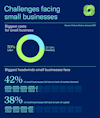Small businesses employ nearly half of the U.S. workforce and represent 43.5% of U.S. GDP. They are an important part of our economic ecosystem where large corporations and small businesses serve as each other's vendors, employees, partners, and customers.
Small businesses fuel the economy.
-
99.9%
Of the companies in the United States are small businesses
-
33.2 m
Small businesses in the United States
Since the late 1990s, small companies have begun to do this It is calculated for Between 43.5% and 50.7% of US GDP, which equates to trillions of dollars in economic activity. In 2014, according to the most recent data available, small businesses generated approximately $5.9 trillion. By comparison, large corporations generated $7.7 trillion in national GDP in the same year.
Small businesses are big employers.
-
45.9%
of Americans work in a small business
-
61.6 m
Americans work in a small business
The majority of small businesses (82%) Operating without employees, small employers who hire employees employ nearly half of the American workforce. Leading industries for small businesses include professional and business services, financial activities, and wholesale and retail trade, comprising between 3.5 and more than 7 million businesses in each sector.

The chart below shows how companies contribute millions of jobs over time. For example, all small businesses with 10 to 19 employees combined add more than 500,000 jobs to the U.S. economy over 10 years. Small businesses pay big bucks. On average, small businesses Pay Employees make $30.42 per hour, which works out to an income of $63,000 over the course of the year.

Entrepreneurship is booming in the United States. Over the past few years, the number of applications to start new businesses has increased. Application numbers doubled in 2020 compared to previous years, and this trend has continued, with more than 5 million new business applications filed annually since then. As of April 2024, 1.75 million requests It has already been introduced this year.
Explore our interactive map below to track the latest data on the increase in entrepreneurship in each state and county Country.
Click on the country for more details.
state
Small businesses are innovative.
Small Business Administration (SBA) data shows that small businesses have historically filed for a significant portion of patents. Companies with 5-9 employees received more patents per employee than any other company, and nearly twice as many patents as large companies in 2016. In the same year, small employers (1-4 employees) applied for More than 270 patents per employee, or 10% of all patents filed for that year.

Small business ownership is also diverse.
The innovation and diversity of small businesses reflects the entrepreneurs behind them. More than 40% of small business owners are women, and four in 10 small business owners were born abroad.
One in five is owned by ethnic minorities, with Latinos making up a large percentage of that number. In fact, according to SBAHispanics are behind one in four new businesses. In all, Hispanic-owned companies pay more than $100 billion in annual salaries to their 1 million workers.

Small businesses are flexible.
Despite facing headwinds including inflation and an ongoing labor shortage crisis, small businesses have proven time and time again their resilience.

This year, although they remain cautious about the country's broader economic outlook, a majority of small business owners report their businesses are in good health, according to the MetLife Index and the U.S. Chamber of Commerce's Small Business Index.
-
65%
Small business owners who say their businesses are healthy
-
67%
Small business owners who say they are comfortable with their cash flow
Small businesses struggle to find and retain good workers.
Labor shortages are one of the major barriers small business leaders face. There are currently 8.5 million open jobs in the United States, but there are only 6.5 million unemployed workers to fill them.
Forty-one percent are small business leaders She indicated More than 90% of employees have difficulty filling job openings and have difficulty finding qualified applicants.
Compounding the battle to find the right workers, 45% of small businesses say they have searched for them. New talent in 2023, up from 33-36% who said the same in 2021. To attract new talent, small businesses reported using a variety of approaches including offering flexible hours (68%) or offering hybrid or remote work options (48 %).
Small businesses use artificial intelligence.
The latest edition of the American Chamber Empowering small businesses The report highlights the critical role that different technology platforms play in helping small businesses overcome challenges – such as workforce shortages and inflation – and how small businesses that embrace technology outperform their peers and are more optimistic about the future.
Companies are also looking to emerging technologies such as artificial intelligence to add to their arsenal of digital tools to compete and expand their businesses. Nearly all U.S. small businesses (95%) report using at least one technology platform.
-
87%
Small businesses reporting increased efficiency due to technology platforms
-
1 in 4
Small businesses using artificial intelligence (AI)
Small business owners obtain capital from many sources to grow their businesses.
Access to growth capital is always a challenge for small businesses. Historically, startups and small businesses (0-4 employees) use personal savings to finance their businesses.
Growth-mode businesses and large small businesses rely primarily on credit cards, community banks and credit unions to fund their operations. The largest small businesses depend on national banks for capital growth.
-
33%
Businesses started with less than $5,000
-
58%
Businesses started with less than $25,000

Small business owners cited that financing applications take a long time, there is little information available on capital sources, and that they simply do not qualify for a loan as the most important barriers to securing financing.
How the US Chamber supports small businesses.
The U.S. Chamber has a long-standing commitment to supporting and advocating for small businesses. We work every day to give small businesses a big voice in Washington, by connecting entrepreneurs and federal officials and advocating for policies that help them grow rather than hinder them.
Our Small Business Council is made up of 100 small business owners from across the country who guide our work in fighting for policies that keep Main Street businesses thriving and regularly visit Capitol Hill.
Since 2017, we have partnered with MetLife to survey small businesses on a quarterly basis for the Small Business Index, which provides valuable insights into current challenges and opportunities for small businesses that inform our congressional advocacy.
Through our small business platform CO—, which helps nearly 20,000 businesses every day and has generated more than six million site visits in the past year alone, we provide small businesses with the tools and insights they need to ensure they are resilient in the face of any challenge. .
Learn more about the small business offerings offered by the U.S. Chamber here.
Looking for the latest small business forecasts?
Each week, the U.S. Chamber of Commerce Vice President of Small Business Policy summarizes the latest data and what it means for the health of America's small businesses.
About the authors

Stephanie Ferguson
Stephanie Ferguson is Director of Global Employment Policy and Special Initiatives. Her work on labor shortages has been cited in the Wall Street Journal, The Washington Post, and the Associated Press.
Read more

Mackenzie Hoover
Mackenzie Hoover is Senior Director of Strategic Advocacy at the U.S. Chamber of Commerce. Her work includes developing and managing end-to-end data center projects that serve as a valuable resource for policy makers, businesses and the public.
Read more

Isabella Lucy
Isabella creates stunning visualizations that address pressing issues such as worker shortages, veteran employment benefits, the longevity of small businesses, and the future of work.
Read more












































